Stellar Evolution
What's covered here:
- What causes stars to eventually "die"?
- What happens when a star like the Sun starts to "die"?
- What happens to the Earth when the Sun starts to "die"?
- What is the final fate for the Sun and other low mass stars?
- What is a nova?
Stars spend most of their lives on the Main Sequence with fusion in the
core providing the energy they need to sustain their structure. There is
a price for this. As a star burns hydrogen (H) into helium (He), the
internal chemical composition changes and this affects the structure and
physical appearance of the star. The older the star, the greater the
amount of helium in the core.
The Sun is currently not on the ZAMS, since it has been burning
hydrogen into helium for about 5 billion years. This is one of the
reasons that the MS appears as a wide strip when it is plotted up. Most
of the stars have been doing fusion for some time, and therefore
altering their internal structure, such that they are removed from the
ZAMS (since the internal changes effect their appearance - their
luminosity and surface temperature).
 Figure 1.
The core of the Sun (and other stars) over time. The top shows how it
started out, with 70% H and 27% He. Over time the size of the helium
core increases, so that it gets larger - as shown in (b), and larger -
as shown in (c). Remember, this is just the core of the star, while the
rest of the star keeps pretty much the same composition while on the
Main Sequence.
Figure 1.
The core of the Sun (and other stars) over time. The top shows how it
started out, with 70% H and 27% He. Over time the size of the helium
core increases, so that it gets larger - as shown in (b), and larger -
as shown in (c). Remember, this is just the core of the star, while the
rest of the star keeps pretty much the same composition while on the
Main Sequence.
The Sun and most other stars originally have a composition of 70%
hydrogen and about 27% helium in their cores. This is sort of the
standard composition of stars like the Sun, at least when they start out
their lives. This is also the current composition of the layers outside
of the core since there is no fusion going on out there, but in the
core things have changed. Now if you were to look inside the Sun's core
today, you would see that there is about 35% hydrogen and 62% helium.
Helium is denser, so it sinks to the center of the core. What does it
do there? Nothing but take up space. Actually, you can think of
helium like a lazy roommate - just sitting around in the middle of the
house, doing nothing and getting bigger each day. Actually, that would
be a pretty gross roommate, but you get the idea.
The helium core is getting larger every day, since the helium that is
produced in the fusion process is just taking up more and more space, since it
can't really do anything else. If you think this is bad, you're right.
The helium, just by its presence, is sort of crowding out the area of
energy production. Remember, fusion can only occur in the hot, high
density area of the core. Outside of this area fusion (and energy
production) will not be happening. With helium taking up more and more
space, there is less space to go into the production of energy. In a
way, the burning region is being forced outward away from the star's center,
it's getting crowded out by the helium.
What is it like as you get further from the core? It's cooler and less
dense (remember those temperature and density graphs from the previous
set of notes?). This is a region that is not hot enough to sustain the
same rate of energy generation as in the hot, dense core. Is that
important? Of course it is important - the energy from fusion helps to
hold up the outer layers of the Sun and maintains the various forms of
stability within the star (like hydrostatic equilibrium and that other
stuff).
What happens when the upper layers are not being held up as effectively
as before? Gravity raises its ugly head, and boy does it have one ugly
head. You have to remember that gravity is always there, but when you
are not fighting its influence very effectively, you pay the price! The
layers outside of the core would start to pull inward, and the
Sun's core and the area around it would slightly contract. While this might not seem like a
good thing, it actually is, since the contraction will help to heat up the area around the
core and get the temperature and density to go up to a level where
fusion can start in regions that were previously too cool or too low
density for fusion to operate.
The basic upshot of this whole thing is that the burning region (energy
production region) of a star is gradually moving further out from the
center of the star as the fusion by-product (helium) is taking up more
and more space in the center.
Does this mean that the Sun is getting larger? No, because you have to
remember that the mass of the Sun has been going down steadily over the
years, since all the energy that it gives off as sunlight was actually
mass at one time. The Sun is losing mass steadily by just giving off
light - a lot easier than Weight Watchers, isn't it? Helium is denser
than hydrogen, so the core is actually getting slowly denser with more
and more helium being produced.
The slow squeezing process seems to have solved the energy problems of
the Sun, right? A little more helium causes the energy production region
to be slowly pushed out from the center - so everything is just fine,
right? Not really, since the Sun (and stars like it) can only do this
for so long. Eventually it will get to the point where the contractions
will not be able to heat up the interior regions high enough to enable
them to produce energy to sustain hydrostatic equilibrium. Even though
there is gravity keeping things hot and dense, it won't be enough to
help the situation. There is a limit to how tightly you can squeeze
stuff and how hot you can get the material.
At this point hydrogen burning in the core is no longer significant,
and there is only a thin shell of hydrogen burning around the large
helium core. The star is pretty much at the end of its Main Sequence
life.
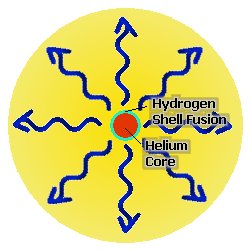 Figure 2.
The outer layers of a star (like the Sun) get pushed out by the compression
and heating of
the core. Even though there isn't much fusion going on, the
gravitational heating of the core causes the heat flow to increase and the outer layers
of the star to swell up.
Figure 2.
The outer layers of a star (like the Sun) get pushed out by the compression
and heating of
the core. Even though there isn't much fusion going on, the
gravitational heating of the core causes the heat flow to increase and the outer layers
of the star to swell up.
The shell burning of
Hydrogen doesn't produce a lot of energy, so it isn't really helping in
holding up the outer layers of the star. Yet the outer layers are being
held up - how? It is pretty much due to all of the hot gas in there, or Thermal Energy, which is just the
heat produced by the squeezing of the core. Remember the influence of
gravity - it will compress and squeeze the core so that the core gets
smaller and hotter. The heat of the core is so great that it will start
to actually overdo the "holding up the outer layers" bit. It will, in
fact, sort of puff out the outer layers of the star. As the outer layers
spread out, they will cool off and the observed surface temperature of
the star will decrease. What do we have here? We get a Red Giant - better start a new
section.
Red Giants
Finally we get to the red giant stage; I know you have been waiting for
this for some time, so just try to stay calm. First, some clarification:
I know that red giants are a bit confusing since there seem to be two
opposite things happening at the same time - the core is getting
smaller and hotter due to compression, while the outer layers are
getting more spread out and cooler. You sort of have things going in
two opposite directions - but these things are related. Without the
heating of the core, there would be no expansion of the outer layers.
In the case of the Sun, it will expand to a size greater than that
of Mars's orbit, or become about 430 times larger than its current
size, and will have a surface temperature of 3500 K and a luminosity
that is 20,000 times its current value. Of course, the core temperature
will be increasing (remember, the squeezing is still going on), getting
closer to around 100 Million K. The size of the Sun will be as big as
the size of Mars's orbit? What will happen to the Earth? - nothing
good, obviously. The Sun will get larger and larger each day, and the
luminosity will increase, so the surface temperature of the Earth will
rise (this is a really big time global warming event). Eventually, after
all life on Earth is destroyed by the intense heat and radiation, the
planet will enter the expanding outer layers of the Sun. If it doesn't
burn up right away, it will probably spiral in toward the center of the
Sun, so it will eventually burn up. I guess not even SPF 40 will help
at that point. Not only will this happen to the Earth, but Mercury,
Venus and Mars will most likely share this fate. Jupiter and Saturn may
be the safe places to be at this time, so you better buy some real
estate out there now while the prices are still low.
The core is being compressed continually, getting hotter and hotter
as well as denser and denser. Is there no limit? Will it ever end? Yes,
it will end; there is a limit. The limit comes about due to some of the
laws of quantum mechanics. One of these laws tell us how tightly we can
pack things in, such as atoms and electrons. Once a star's core gets to
the point where the electrons are packed in as tightly as possible, the
material is said to be electron
degenerate. The core of a red giant is therefore becoming more
and more electron degenerate. One of the unusual properties of electron
degenerate material is that once it is electron degenerate, you can't
make it any denser. No matter how hard you squeeze and compress it, it
will not get any denser - it will get hotter, but not denser.
Another thing that happens with a red giant is that the outer layers
become very convective. Actually, there are huge convective bubbles
reaching down all the way to the core and then back up to the surface.
For a star that is as large as the size of Mars's orbit, these are some seriously
large bubbles! One neat aspect of these huge convection bubbles is that they
can mix up material really nicely. Sometimes they can even pull some
stuff from the core onto the surface. Red giants can have rather
peculiar chemical compositions in their surface layers, since the high
density stuff in the core can get mixed in with the material in the outer layers, which
we can see when we obtain a spectrum. This is something that astronomers have seen with red
giants, and is a feature that is predicted by our computer programs as
well.
It's time to get back to the core. When the core temperature reaches
100 million K, it is hot enough for helium fusion to occur. Believe it
or not, this is a good thing. Actually, it isn't so good at first, since
the core of the star is electron degenerate when the helium ignites,
and the resulting ignition is a rather catastrophic event. This Helium
Flash marks the rapid onset of helium burning in the core for a low
mass star. A helium flash is a rather violent explosion that can
significantly alter the internal structure of a star, in part because
the material in the core is so electron degenerate. We can't actually
see the helium flash, since it is buried deep in the core, and it
happens relatively quickly, but it does get the star back on the fusion
track. Stars more massive than the Sun usually don't have an electron
degenerate core, so when their helium ignites it's no big deal. In the
case of the low mass stars, the helium flash also has the added bonus
of removing the electron degeneracy in the core.
Now we have sort of a happy star - it has gotten its second wind.
The helium fusion is making a good amount of energy in the core and the
core is no longer electron degenerate. Unfortunately, the helium burning
is not as energy efficient as hydrogen burning, so you get less bang
for the buck. You might want to think of it as a lower quality fuel,
perhaps a lower octane than hydrogen fusion. The basic upshot is that
not as much energy is produced in each helium fusion reaction as was
produced in each hydrogen fusion reaction, so the star has to burn the
helium faster to produce a sufficient amount of energy. The core is
still extremely hot, so it is producing a lot of thermal energy as well,
which will keep the outer layers puffed up, so the star is still a cool
red giant.
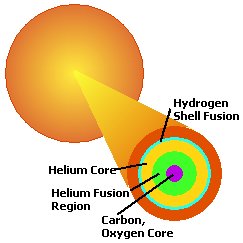 Figure 3. The interior of a red giant after helium
fusion starts. The size of the star is on the order of a couple of
hundred A.U.s, while the core is only about as large as the Earth. The
close up for the core shows that multiple layers exist. At the center
are the by-products of the helium fusion - carbon and oxygen. Above
that there is a layer of helium that is undergoing fusion and another
layer of helium that isn't fusing (too cool or low dense). Above the
helium layers is the layer of hydrogen fusion in a very small shell.
This layer marks the outer edge of the core. The rest of the star is
for the most part the same composition that the star had to begin with
(mainly hydrogen and helium).
Figure 3. The interior of a red giant after helium
fusion starts. The size of the star is on the order of a couple of
hundred A.U.s, while the core is only about as large as the Earth. The
close up for the core shows that multiple layers exist. At the center
are the by-products of the helium fusion - carbon and oxygen. Above
that there is a layer of helium that is undergoing fusion and another
layer of helium that isn't fusing (too cool or low dense). Above the
helium layers is the layer of hydrogen fusion in a very small shell.
This layer marks the outer edge of the core. The rest of the star is
for the most part the same composition that the star had to begin with
(mainly hydrogen and helium).
Now helium fuses into carbon (C) and oxygen (O) through what is
known as the triple alpha process.
This is sort of a silly sounding name, but it comes from the old
fashioned name for helium (alpha particle), and when you combine three
helium atoms together, you make carbon (as well as energy), while four
helium atoms will combine to make oxygen (and energy). I guess it could
be called the quadruple alpha process, but that isn't as easy to
pronounce. Any ways, let's get back to the fusion of helium. Helium
fusion is less efficient than hydrogen fusion, so it goes pretty fast
and the carbon and oxygen will start to take up more and more space in
the core of the star. Does this sound familiar? It should. Again, the
burning will move out further and further away from the center of the
star and the core will start to get degenerate again. As new regions of
helium start to burn, the star can experience Helium Shell Flashes (also called thermal pulses). These are similar
to the explosive helium flash, but less powerful since less material is
involved and it isn't as degenerate as the core was when the helium
flash occurred. These helium shell flashes are rather troublesome,
though, since they do release a fair amount of energy - kind of like
violent, uncontrollable hiccups.
After about 1 billion years (for stars similar to the Sun), the
build up of carbon and oxygen in the core will prevent the production
of a significant amount of energy, since the darn carbon and oxygen are
taking up so much space. This marks the end of the line for the star.
The core will start contracting, but the contraction will not produce
high enough temperatures or densities to ignite the next fusion process.
A star will spend only about 10% of its life as a red giant - not much
for a second lifetime, but you take what you can get.
Is the end of helium burning the end for all stars? No, stars more
massive than the Sun may be able to continue into the next burning
stages once the helium fusion stage stops. Remember, more mass leads to
more gravitational pull (or contraction), which leads to more squeezing
of the core. More squeezing leads to higher temperatures and densities.
For these larger mass stars carbon would burn next, and then heavier
elements after carbon, but only if the star is massive enough to raise
the temperature and density to the high levels required for the fusion
of these heavier elements. The star will remain a red giant and
basically just hang around in the upper right area of the H-R diagram
until it finishes all of its fusion stages. Different mass stars tend to
be arranged with the higher mass stars further up on the H-R diagram,
but that's not always true - the arrangement of the stars in the red
giant stage isn't as nice and orderly as it was during the Main
Sequence stage. It is rather difficult to precisely determine the mass
of a red giant star.
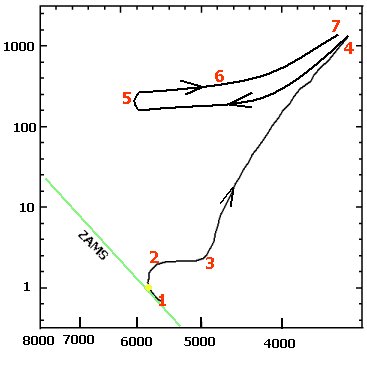 Figure 4.
The various steps of the Sun's evolution are outlined here. This is also
the way that most other low mass stars similar in mass to the Sun will
evolve. The current location of the Sun is indicated by the yellow dot
along the evolutionary path. The direction of evolution is indicated by
the arrows.
Figure 4.
The various steps of the Sun's evolution are outlined here. This is also
the way that most other low mass stars similar in mass to the Sun will
evolve. The current location of the Sun is indicated by the yellow dot
along the evolutionary path. The direction of evolution is indicated by
the arrows.
Before we find out how a star like the Sun ends its existence, let's
recap the fusion history of a low mass star like the Sun. The various
points listed below are marked in Figure 4.
- Hydrogen is undergoing fusion in the core, which produces helium
and energy. The star is happily doing this for 90% of its life, which
is the amount of time it spends on the Main Sequence. This
amounts to a total MS life of about 10 billion years for the Sun.
- Hydrogen fusion in the core ceases for the most part, with only
hydrogen fusion in a thin shell still occurring. The star from this
point on is a red giant. While the outer layers get puffed up, the
compression in the center starts to form an electron degenerate core.
- Hydrogen shell burning continues in a small layer around the
degenerate core. The fluffy red giant is rather unstable, and the outer
layers get very convective. This can bring up some of the heavy
elements from the center to the surface, which produce some rather
bizarre spectra.
- Helium Flash signals the start of helium fusion in the core.
- Helium core fusion producing energy and the byproducts of carbon
and oxygen begins. There is also a thin layer of hydrogen shell burning
around the helium core, though this isn't producing as much energy as
the helium fusion.
- Helium core burning decreases as the carbon and oxygen build up
so there is only helium and hydrogen burning in thin shells. This is
also the time when helium shell flashes would occur, causing
disruptions in the structure of the star.
- What comes next? That depends upon mass, with higher mass stars
continuing on with further stages of fusion - maybe one more fusion
stage, maybe two, or maybe three. It all depends on the mass of the star
- more mass, more fusion.
For a star like the Sun, after step 7, it is pretty much dead.
Follow this link to see the evolutionary
paths of several other stars as they evolve from the Main Sequence
through their helium fusion phases. But what happens after
the helium fusion? How does a star like the Sun actually die?
I'll get to that in a moment, but first, a small diversion.
Brown Dwarfs
Believe it or not, there are some stars out there that are more boring
than the Sun. This would be those that have very low masses compared to
the Sun. How low? Low enough so that they don't even get to do any
helium fusion - these stars only have a hydrogen fusion stage and after
that, they're pretty much dead. This is likely the fate of stars less
than 20% of the mass of the Sun - likely those that are Main Sequence
types M5 and cooler.
 Figure 5. The coolest brown dwarf yet discovered, WISE 1828+2650, with
a surface temperature of only about 300 K, (80 Fahrenheit). The colors are not true
color - click on the image to see the larger view.
Image credit: NASA/JPL-Caltech/UCLA.
Figure 5. The coolest brown dwarf yet discovered, WISE 1828+2650, with
a surface temperature of only about 300 K, (80 Fahrenheit). The colors are not true
color - click on the image to see the larger view.
Image credit: NASA/JPL-Caltech/UCLA.
What's the limit for hydrogen fusion? The lowest mass that a star can
have and be able to fuse hydrogen is about 8% the mass of the Sun.
Remember that when stars form, the vast majority of those that form are
very low mass, so there should be a lot of these very small objects out there.
What do we call these really low mass not-quite-stars? These are
known as Brown Dwarfs.
These stars have surface temperatures of only about 1000 K and less, and
have a fraction of the Sun's luminosity. Such objects
would be very difficult to detect, and seem to have the characteristics of
the L and T type stars. So are L stars really brown dwarfs? No necessarily.
Some L stars are large enough to fuse hydrogen and therefore aren't brown dwarfs, while
other L stars are too small to fuse hydrogen and should be viewed as brown dwarfs. It is
more likely that all of the T types are brown dwarfs. It is really hard to determine
which of these stars are fusing hydrogen and which aren't since they give
off very little light and it is very hard to see them and accurately measure
their characteristics. We have to use
IR telescopes like Spitzer and WISE to detect them.
In fact, the Spitzer has found not only brown dwarfs
but also disks of dust around them - which sort of stand out
since thees are quite large disks. So far the coolest (and perhaps the smallest)
stars are classified as T9 types, with temperatures down to about 500-600 K.
Are there stars cooler/smaller than brown dwarfs? Of course there are.
Astronomers have suggested that there be another spectral type beyond
T stars, and these cool objects would be known as "Y" type brown dwarfs, or sub-brown dwarfs.
Unfortunately so few Y type stars have been found that it is difficult to understand their
characteristics and also to determine if they should actually be planets and not
stars. Generally if they are free-floating, and not part of a binary or multiple star system, then
they should be viewed as "star-like", at least in how they formed. At present the coolest such
objects is also relatively close to us - WISE 0855-0714 is only 2.2 pc from the Sun. Based upon observations by the WISE and
Spitzer infrared telescopes, this object has a temperature of between 225-260 K. Those are the
sorts of temperatures you'd experience in Antarctica! So is it a star or a planet? At this point
it may be best described as a failed star.
While it is very difficult to just find a brown dwarf, it is also very
difficult to measure their masses. This was recently done, where
astronomers were able to measure the masses of two brown dwarfs and
found masses of only about
3%
the mass of the Sun.
Brown dwarfs may also play a role in the structure of our
galaxy since they should be very common and could contribute substantially
to the overall mass of the galaxy.
For stellar evolution, Brown Dwarfs are pretty much a dead end, since
they have no fusion, they don't change or evolve in any way and just
cool down over time, which is pretty boring.
Since we want to see things that are more exciting than brown dwarfs, we need to
return to the discussion of a star like the Sun to see what happens after it finishes
all of its fusion stages.
Stellar Death
The life stages of a star will depend mainly on one factor - its mass.
How long it lives, how it will die, what it will fuse in its core - all of these
depend upon the mass. Though different mass stars will evolve in
slightly different ways, many will do the same sort of general things so
that we can group them together. We'll first look at the case of the
small stars like the Sun.
Low Mass Death (for stars like the Sun)
Eventually the red giant phase will end when the star can no longer
burn anything in its core. For the Sun, the last element it will burn is
helium. Other, more massive stars will burn carbon, oxygen or neon in
their cores and other heavy elements if they are massive enough. Of
course, each time a star burns an element it produces heavier elements
as by-products. Eventually they will have to stop burning since their cores
can't get hot or dense enough for the next burning cycle to start.
When a star stops fusing an element it evolves towards the upper right
corner of the H-R diagram. This is because of the compression of the
core and the resulting expansion of the outer layers. The star is
getting more and more puffed up. This is also a time when the convection
in the outer layers is very extreme, so that the entire star is almost
completely convective. If that weren't bad enough, in low mass stars
like the Sun, the Helium Shell Flashes will keep occurring every once
in a while and these will release a lot of energy in short bursts. This
is rather like having a very nasty case of the hiccups - with the outer
layers of the star actually being pushed outward. Another aspect of
stars in this stage of their lives is the development of very strong
stellar winds (really super winds). With the stretched out surface layers, the
Helium Shell Flashes, and the super winds, there is so much going on to
push the outer layers even further out. The combined energy of all
these processes can help to blow off the outer layers of the star.
Actually, this is not too difficult to do since the outer layers of the
star are already stretched out quite a ways from the core (remember, it
is a red GIANT) and so it is harder for the star to hold onto them
effectively (the further from the center, the lower the gravity).
The end result is that the outer layers get blown off. As the outer
layers get blown off, there will be a lot of hot gas flowing away from the
star, which used to be the outer layers and there will only be the core
of the star left behind. Sometimes the material will be ejected as a ring, sometimes the material gets blown off in
two directions (remember bipolar outflow);
it is also possible that the material will be blown out in bubbles. The
animations provided are based upon various theories of how material is
ejected. In the case of the bipolar outflow, it is believed that the
interactions of two stars cause the funnel shaped outflow. In any event
a large amount of material (basically all of the stuff outside of the
core) gets blown out into space. This produces a structure known as a
Planetary Nebula - and in the great tradition of naming things in
astronomy, it has nothing to do with planets! It's just that in the old
days when people looked at these things with telescopes, they saw that most Planetary
Nebulae had disk shapes, and the only other things visible with such
shapes were planets. Yes, that's a pretty lame reason, but we're stuck
with it.
It's time to get back to killing off stars. During the rather nasty
Planetary Nebula stage, stars like the Sun will lose about 40% or more
of their mass. More massive stars will lose an even greater fraction of
their mass. Some Planetary Nebulae are not nice and perfectly
spherical - some have rather unusual shapes, possibly due to irregular
mass loss or several different phases of mass loss. Typically Planetary
Nebulae are a few light-years in size and the gas is still moving away
from the star at relatively high velocities (a few thousand km/s). The
gas in a Planetary Nebula will stay rather hot due to the heat from the
hot, dense core, so they are visible for many years after the start of
this phase.
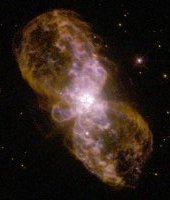 |
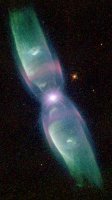 |
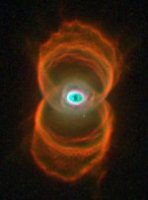 |
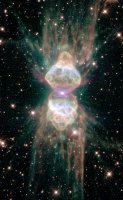 |
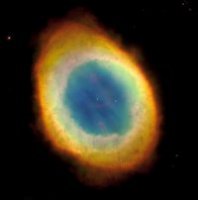 |
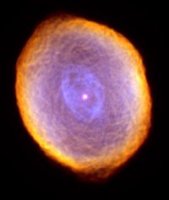 |
Figure 6. Examples of Planetary Nebulae. All images
are from the Hubble Space Telescope. The top row shows the common
bipolar outflow shaped nebulae, where material is ejected in two
directions (assumed to be out the poles). The different shapes
may be due to how the nebulae are tilted toward or away from us, or how
well aligned the ejected material is. The two images at left are of the
circular variety of the planetary nebulae. Initially it was thought
that these circular shapes were due to a circular or spherical ejection
of material, though some now think that the circular shape could be due
to a end-on alignment of the bipolar types. Image credits:
NASA, ESA, The Hubble Heritage Team (STScI/AURA), Bruce Balick
(University of Washington), Vincent Icke (Leiden University, The
Netherlands), Garrelt Mellema (Stockholm University), R. Sahai & J.
Trauger (JPL). |
Over time the ouflow of gas from the star will stop and the gas in the
Planetary Nebula will cool down and get lost amongst the rest of the gas
floating around in space. A nifty thing about this material is that it is often
enriched with heavy elements - remember, this phase comes after a star
has finished doing all of those various fusion processes, so that there
is an excess of heavy elements in the material. This is one way that
heavy elements (stuff other than hydrogen and helium) can get deposited
into space. This is an important point that we'll bring up again later.
All that is left of the star after the Planetary Nebula stage is the
hot little core. What is the core doing? It isn't burning, but it still
has to deal with the influence of gravity, which will compress the core
down to the point where the material is again electron degenerate. Once
it gets to that point, the compression will stop. The star is now a hot,
dense but stable object. That's pretty boring, but also pretty bizarre
in a way - it's still electron degenerate, which makes it rather
abnormal.
The core that is left over will have a mass that is about 1/2 the
mass of the Sun, but it will have a radius comparable to the that of
the Earth (around 6000 km). The surface temperature will be up to
100,000 K, but it will cool off in time. The density of this object is
about 1 million grams per cubic cm. This is about the same as the
density of a Volkswagen - not a regular Volkswagen, but one that has
been crushed down to the size of a sugar cube. Pretty dense, eh?
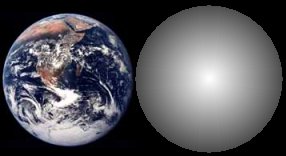 Figure 7. A
typical white dwarf (right) compared to the Earth (left). Even though
it has a radius similar to the Earth, the mass of a white dwarf is much
closer to that of the Sun. This makes it a very dense object. Earth
image courtesy of NASA.
Figure 7. A
typical white dwarf (right) compared to the Earth (left). Even though
it has a radius similar to the Earth, the mass of a white dwarf is much
closer to that of the Sun. This makes it a very dense object. Earth
image courtesy of NASA.
What do we call this hot, dense, small sized object? A White Dwarf - actually, this
name kind of makes sense; it's small and it's hot - wow, a name of
something in astronomy that actually makes sense.
Now there is a really nifty thing about white dwarfs. They are electron
degenerate objects, so they don't obey the same laws of physics that
normal stuff does. Someone noted a rather interesting consequence of
this feature. A young student who was thinking about these things,
Subrahmanya Chandrasekhar, came to a rather startling realization - that
if you added more mass to a white dwarf, it got smaller in size
(radius). More mass, more shrinking - this doesn't make sense, but this
is the way degenerate material acts. Chandrasekhar eventually figured
out that if you added enough mass, the white dwarf would be shrunk to a
size of 0! Which means it could not exist - you can't have things that
have no size, after all (later we'll sort of break this rule).
Chandrasekhar determined that if an object is electron degenerate it
cannot have a mass greater than 1.4 solar masses; any bigger than this
and it would shrink out of existence - it just could not hold itself up
anymore. All of the white dwarfs that we know of are stable, so they
must all be less than 1.4 solar masses. Actually, where we can measure
their masses, we always find that they are less than 1.4 solar masses.
This mass limit is known as the Chandrasekhar
Limit. Perhaps the best way of thinking of the Chandrasekhar
limit is just like a wrestler trying to get under their weight limit,
however in the case of the wrestler, he would still exist if he were
overweight, unlike the white dwarf.
For a star to eventually end up being a white dwarf, it must get
below the Chandrasekhar limit (1.4 solar masses). Some astronomers
think that stars that started out their Main Sequence lives with about
8 times the Sun's mass can end up as white dwarfs. For this to happen,
they must lose at least 6.6 solar masses on the way to being a white
dwarf - that's sure a lot of material, and it can lose a large amount
of that material in the Planetary Nebula stage, though it can also lose
it in other ways, such as with a steady, strong stellar wind.
Regardless of how it does it, it still has to do it! If it doesn't, the
star won't end up as a white dwarf, but something else will happen (as
you'll see later).
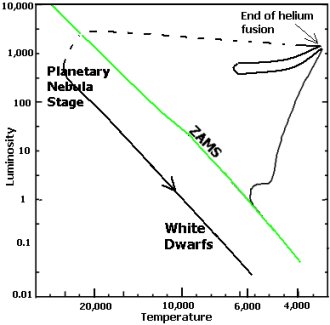 Figure 8.
The entire evolution of a star like the sun, from the Main Sequence,
through helium fusion and the planetary nebula stage, down to the white
dwarf and ultimately black dwarf stage. The line from the end of the
helium fusion stage to the planetary nebula stage is not drawn in since
this path is not well known.
Figure 8.
The entire evolution of a star like the sun, from the Main Sequence,
through helium fusion and the planetary nebula stage, down to the white
dwarf and ultimately black dwarf stage. The line from the end of the
helium fusion stage to the planetary nebula stage is not drawn in since
this path is not well known.
In Figure 8, the evolution of the Sun is diagrammed from the ZAMS
all the way to the white dwarf stage. You may notice that there is no
solid line between the end of the helium fusion stage and the Planetary
Nebula stage since this part of the star's evolution is kind of
difficult to plot. At the start of this span, the star is a very cool
red giant with a hot, compressed core. Then, when the Planetary Nebula
stage starts, it basically starts to peel off the cool outer layers,
revealing the hot core. In a way it sort of jumps from the far right
side of the H-R diagram all the way to the left side in a very short
time.
When the Sun eventually goes through the Planetary Nebula stage, it
should lose about 0.4 solar masses and end up as a 0.6 solar mass white
dwarf. That's not very exciting, but what else can it do? - nothing.
About the only thing that a white dwarf can do is cool down. Eventually
it will get cooler and less bright (remember how luminosity
depends on temperature) until it gets too cool to see. Once a white
dwarf completely cools down, it will become a black dwarf. However, that takes
such a long, long time that there are no black dwarfs currently in the
Universe (the Universe isn't old enough for any to exist). A rather
nifty animation showing the size of a white dwarf and its ultimate fate
can be seen here.
What about stars more massive than the Sun? More mass means more
gravity, more gravity means more heat in the core, and more heat in the
core means more fusion cycles can occur. These stars have the chance to
start burning other elements, like carbon or oxygen. The more mass a
star has, the more fusion cycles it can go through. Remember, it does
this very quickly - big stars use up their fuel rapidly. Even though
they have more fuel, they are not very economical in its usage. Even
though they can burn more stuff then the Sun, they are still not very
careful in how they use it. Big stars will eventually end up as white
dwarfs but they tend to go through a few more burning cycles. On the H-R
diagram, when these stars are burning other elements, they would just
sort of wander around the area that red giants or red supergiants are
found in. They'll stay as red giants or supergiants so long as the
fuels lasts, but when it does run out, they'll end up down in the white
dwarf location (after going through a Planetary Nebula stage), just like
the Sun.
Not all white dwarfs are the same - they can have very different
compositions. Remember, a white dwarf is the remains of the core, so
whatever the core of the star is made of ends up being what the white
dwarf is made up of. For a very low mass star, it will only go through
the hydrogen fusion cycle where it produces helium. That star's white
dwarf should be made mainly of helium. A star like the Sun will burn
helium, producing carbon and oxygen. The Sun's white dwarf will be made
mainly of carbon and oxygen. There are white dwarfs out there made of
various things like mixes of oxygen, neon and magnesium, to name a few.
The larger the star was on the main sequence, the heavier the final
fusion product will be - and this will determine the final composition
of the white dwarf. Now let's look at an interesting fate for some white
dwarfs.
Nova
If a white dwarf is sitting all by itself in space like the Sun's white
dwarf will be, not much else will happen with it. If it is a binary
system, especially a close binary system where things are really tight,
it can get very interesting indeed.
It is possible for mass to transfer from one star to another in a close
binary system. This can happen in certain stages of the binary star
system's evolution. One example of what can happen is the following -
let's say you have two stars of slightly different mass. The more
massive star will die first (remember, mass determines fate and big mass
means short life), the big star will go through its various stages of
evolution and end up as a white dwarf before the less massive star has
a chance to even do much of anything. In fact, the lower mass star will
still be on the Main Sequence long after the other star goes through
its entire life. You now have a white dwarf star and a Main Sequence
star. Eventually the remaining MS star will start to die and will enter
the Red Giant stage - nothing unusual about that. As it puffs up it
will get larger and larger and will fill up a gravitational boundary,
the Roche Lobe, around the
binary system.
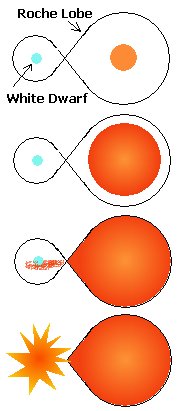 Figure 9. The ingredients needed for a nova. Two
stars, one a white dwarf, the other a star becoming a red giant, are in
orbit about one another. The Roche Lobe marks the gravitational limit
for each star. As the red giant expands, the material in its outer
layers don't expand out in any direction due to the proximity of the
nearby white dwarf, so the material is funneled toward it. This is due
to the constraints of the Roche Lobes. Eventually the material on the
white dwarf will ignite as a nova.
Figure 9. The ingredients needed for a nova. Two
stars, one a white dwarf, the other a star becoming a red giant, are in
orbit about one another. The Roche Lobe marks the gravitational limit
for each star. As the red giant expands, the material in its outer
layers don't expand out in any direction due to the proximity of the
nearby white dwarf, so the material is funneled toward it. This is due
to the constraints of the Roche Lobes. Eventually the material on the
white dwarf will ignite as a nova.
The Roche Lobe isn't a physical barrier like a wall, but it just
defines how the gravitational pull of the binary system causes material
to move in certain ways. As the red giant fills up its side of the Roche
Lobe, the material will not just expand outwards, but will instead be
funneled towards the other star - that's all due to our electron
degenerate friend's high gravity. Now the material from the red giant
is being transferred over to the other star in the system, which in
this case is a white dwarf. This cannot be good! The material
transferring from the red giant will not just dump directly onto the
white dwarf since the whole system is moving and things are going
around in orbits, so the material sort of spirals in. It will gradually build up a
disk around the white dwarf. The material builds up around the white
dwarf into what is called an accretion
disk. The white dwarf is rather hot and the material gets heated
up in the process of spiraling in, so it will tend to give off
ultraviolet (UV) radiation. This is good, since it provides a way for
astronomers to identify such binary systems. Remember, this is in a
binary system and the only thing that might be visible in a regular
telescope is the red giant, which is too cool to produce any large
quantities of UV radiation. The presence of the large amounts of UV
radiation points to an unseen accretion disk with a white dwarf buried
inside it. Gradually material will get to the white dwarf and build up
on its surface. What type of material is it? It is what the outer
layers of stars are made up of, which is the regular mix of mainly
hydrogen with some helium in it.
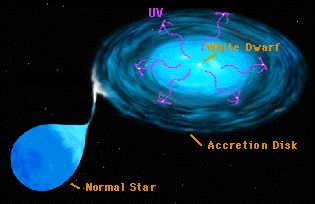 Figure 10.
The set up for a nova - one star getting material ripped off, another
star (white dwarf) pulling the material in. The material forms an
accretion disk which will heat up to the point where it gives off UV
light.
Figure 10.
The set up for a nova - one star getting material ripped off, another
star (white dwarf) pulling the material in. The material forms an
accretion disk which will heat up to the point where it gives off UV
light.
Now we have a white dwarf getting dumped on. After some time (years,
or perhaps even decades), the material that accumulates on the surface
of the white dwarf will ignite in an explosive blast. This explosion
has a brightness about 100,000 times greater than the Sun's luminosity.
What you have here is a
Nova.
Novae (that's the plural form) will stay bright for weeks, but are not
as bright as supernovae (which we'll get to later). While the explosion
is pretty powerful, energetic and bright, it doesn't destroy the stars
involved. The nova is produced by mass being transferred in a binary
system, so it is possible for it to happen again and again in the same
star system. This is known as a recurrent novae. There are
10 known recurrent novae in our galaxy.
The current record holder for most frequent eruptions is
U Scorpii (in the constellation of Scorpius). This system went nova
in 1863, 1906, 1917, 1936, 1945, 1969, 1979, 1987, 1999 and 2010.
Click here to see the light variation of
U Scorpii during the 2010 nova. I guess a recurrent
nova is sort of like a repeat offender - they just can't help
themselves and keep doing the same thing over and over. In the case of
U Scorpii, even though it has gone off at least 10 times, it is possible that it
could go off again!
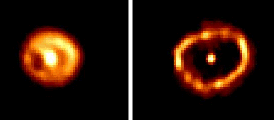 Figure 11.
Nova Cygni seen at two different times, 1992 and 1993 (left and right
respectively). The expansion of the blast shell over time is obvious in
the two images. The two stars that are the source of the nova appear
like one star in the middle. Image credit: F. Paresce, R. Jedrzejewski
(STScI) NASA/ESA.
Figure 11.
Nova Cygni seen at two different times, 1992 and 1993 (left and right
respectively). The expansion of the blast shell over time is obvious in
the two images. The two stars that are the source of the nova appear
like one star in the middle. Image credit: F. Paresce, R. Jedrzejewski
(STScI) NASA/ESA.
Novae are so bright that they can at times be seen in other galaxies
millions of light-years away. Eventually the explosion will fade away,
though it did cause a nice light show while it lasted. There can be
dozens or hundreds of novae occurring in a galaxy each year, since there
are so many white dwarfs out there. A system that produces a nova will
not be able to repeat the process forever, since eventually the red
giant will become a white dwarf, so you'll end up having a system
containing two white dwarfs. What will these white dwarfs do? - nothing
but cool off slowly, eventually becoming a pair of black dwarfs, but
that takes a very long time. They end up being pretty dull and boring in
the end.
The Sun will not become a nova (remember, it takes two stars to have a
nova), so it will have a pretty boring end. Sorry, folks, this is pretty
much the end of the line for low mass stars like the Sun.
Now that you've read this section, you should be able to answer these questions....
- How does the interior of the Sun change over time? What effect does this have on the rest of the Sun?
- What happens when the hydrogen runs out?
- What happens to the planets when the Sun goes through its Red Giant phase?
- What are the characteristics of a Red Giant?
- What causes helium fusion to start?
- What happens once helium fusion ceases?
- What happens during the Planetary Nebula stage?
- What are the characteristics of a White Dwarf?
- What is the Chandrasekhar limit?
- How can the evolution of a star like the Sun be depicted on an H-R Diagram?
- What is needed to produce a nova?
 Figure 1.
The core of the Sun (and other stars) over time. The top shows how it
started out, with 70% H and 27% He. Over time the size of the helium
core increases, so that it gets larger - as shown in (b), and larger -
as shown in (c). Remember, this is just the core of the star, while the
rest of the star keeps pretty much the same composition while on the
Main Sequence.
Figure 1.
The core of the Sun (and other stars) over time. The top shows how it
started out, with 70% H and 27% He. Over time the size of the helium
core increases, so that it gets larger - as shown in (b), and larger -
as shown in (c). Remember, this is just the core of the star, while the
rest of the star keeps pretty much the same composition while on the
Main Sequence.  Figure 2.
The outer layers of a star (like the Sun) get pushed out by the compression
and heating of
the core. Even though there isn't much fusion going on, the
gravitational heating of the core causes the heat flow to increase and the outer layers
of the star to swell up.
Figure 2.
The outer layers of a star (like the Sun) get pushed out by the compression
and heating of
the core. Even though there isn't much fusion going on, the
gravitational heating of the core causes the heat flow to increase and the outer layers
of the star to swell up.  Figure 3.
Figure 3.  Figure 4.
The various steps of the Sun's evolution are outlined here. This is also
the way that most other low mass stars similar in mass to the Sun will
evolve. The current location of the Sun is indicated by the yellow dot
along the evolutionary path. The direction of evolution is indicated by
the arrows.
Figure 4.
The various steps of the Sun's evolution are outlined here. This is also
the way that most other low mass stars similar in mass to the Sun will
evolve. The current location of the Sun is indicated by the yellow dot
along the evolutionary path. The direction of evolution is indicated by
the arrows. 






 Figure 7. A
typical white dwarf (right) compared to the Earth (left). Even though
it has a radius similar to the Earth, the mass of a white dwarf is much
closer to that of the Sun. This makes it a very dense object. Earth
image courtesy of NASA.
Figure 7. A
typical white dwarf (right) compared to the Earth (left). Even though
it has a radius similar to the Earth, the mass of a white dwarf is much
closer to that of the Sun. This makes it a very dense object. Earth
image courtesy of NASA.  Figure 8.
The entire evolution of a star like the sun, from the Main Sequence,
through helium fusion and the planetary nebula stage, down to the white
dwarf and ultimately black dwarf stage. The line from the end of the
helium fusion stage to the planetary nebula stage is not drawn in since
this path is not well known.
Figure 8.
The entire evolution of a star like the sun, from the Main Sequence,
through helium fusion and the planetary nebula stage, down to the white
dwarf and ultimately black dwarf stage. The line from the end of the
helium fusion stage to the planetary nebula stage is not drawn in since
this path is not well known.  Figure 9.
Figure 9.  Figure 10.
The set up for a nova - one star getting material ripped off, another
star (white dwarf) pulling the material in. The material forms an
accretion disk which will heat up to the point where it gives off UV
light.
Figure 10.
The set up for a nova - one star getting material ripped off, another
star (white dwarf) pulling the material in. The material forms an
accretion disk which will heat up to the point where it gives off UV
light.  Figure 11.
Nova Cygni seen at two different times, 1992 and 1993 (left and right
respectively). The expansion of the blast shell over time is obvious in
the two images. The two stars that are the source of the nova appear
like one star in the middle. Image credit: F. Paresce, R. Jedrzejewski
(STScI) NASA/ESA.
Figure 11.
Nova Cygni seen at two different times, 1992 and 1993 (left and right
respectively). The expansion of the blast shell over time is obvious in
the two images. The two stars that are the source of the nova appear
like one star in the middle. Image credit: F. Paresce, R. Jedrzejewski
(STScI) NASA/ESA.